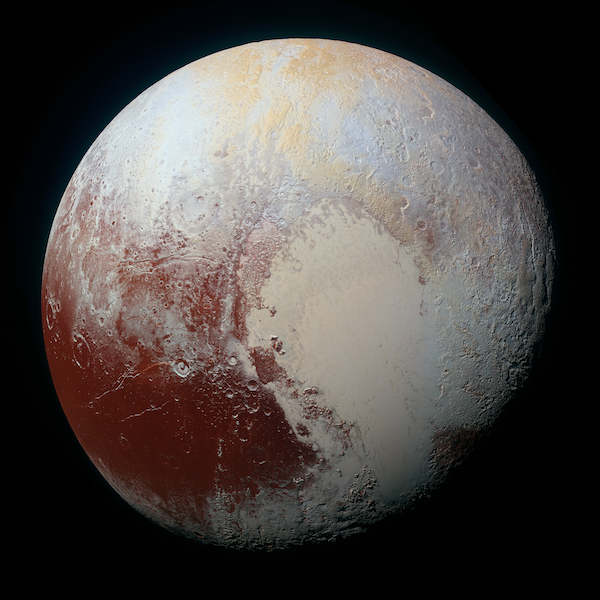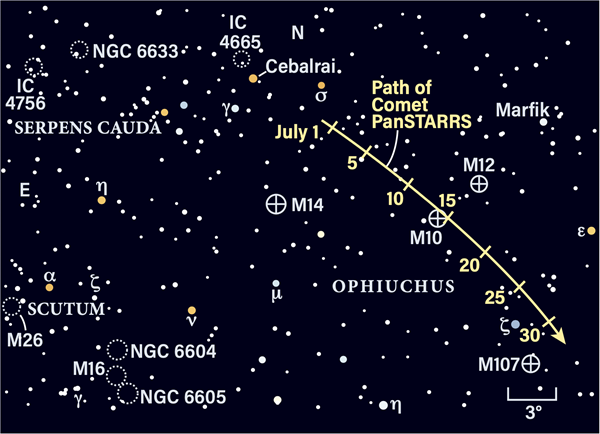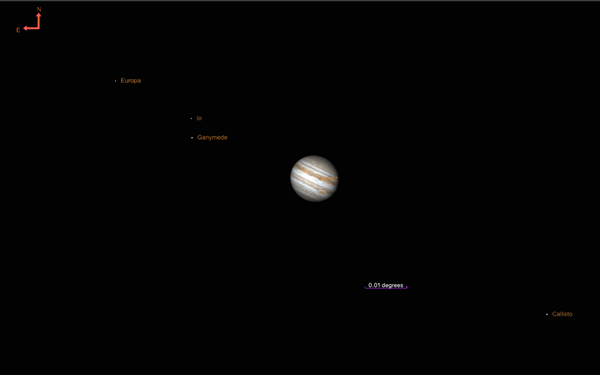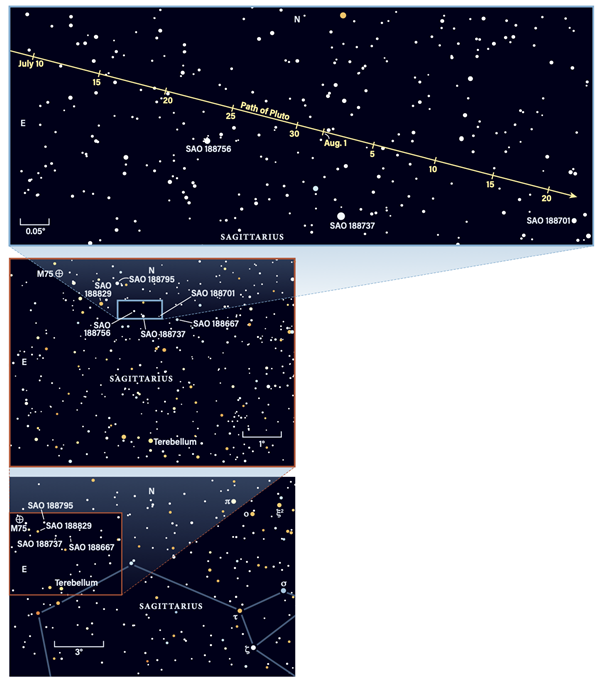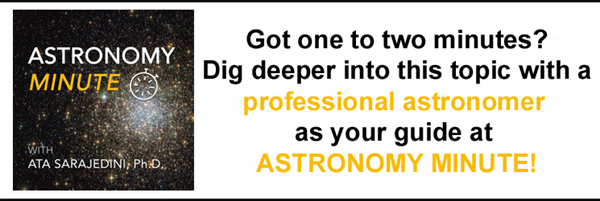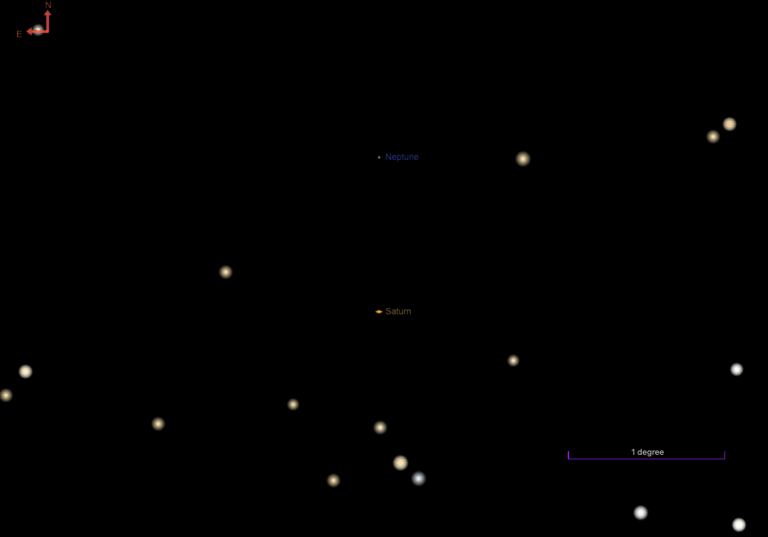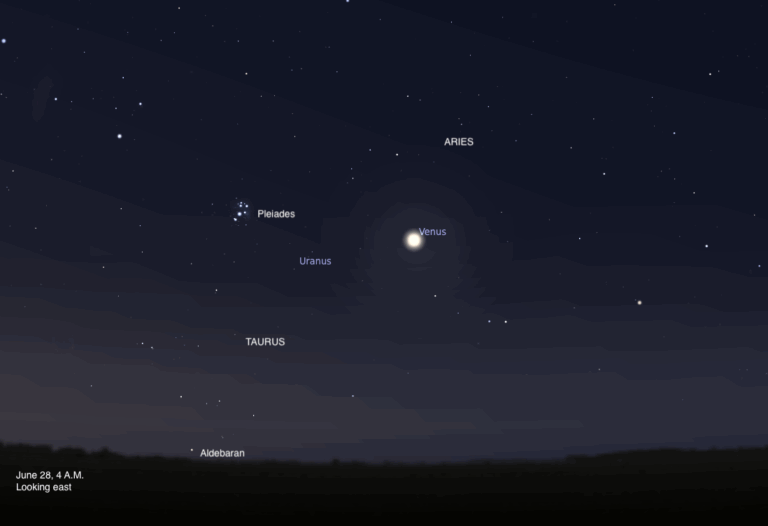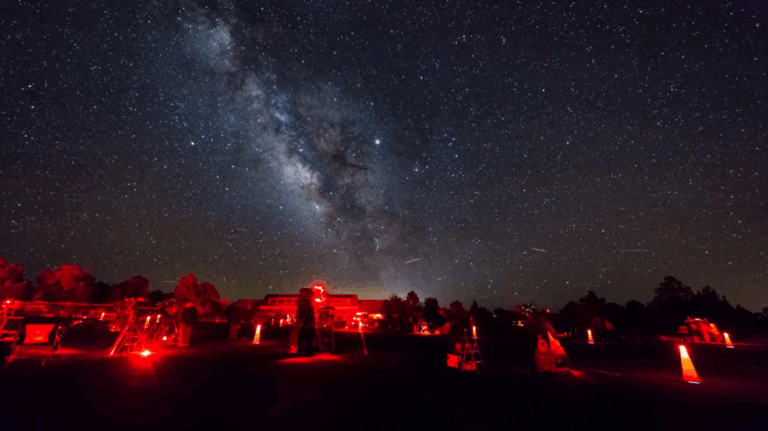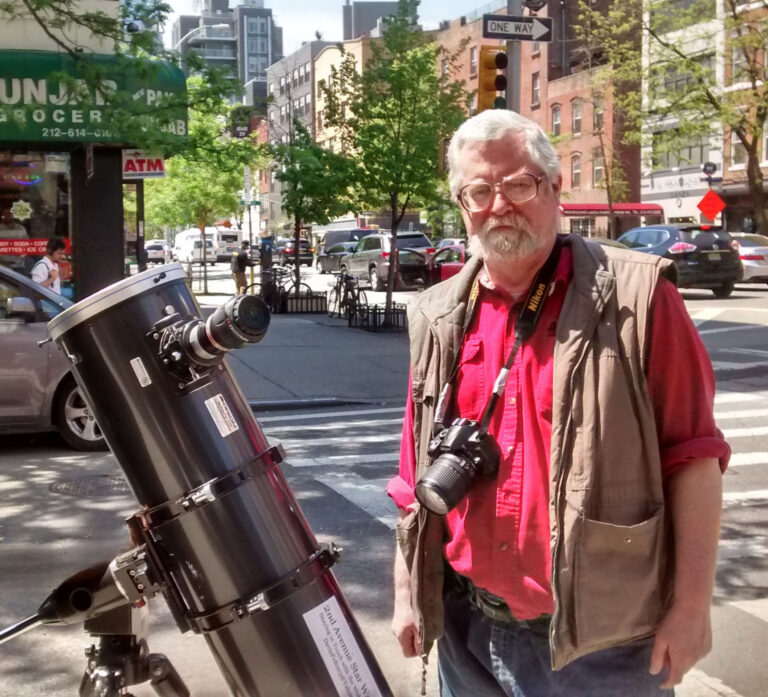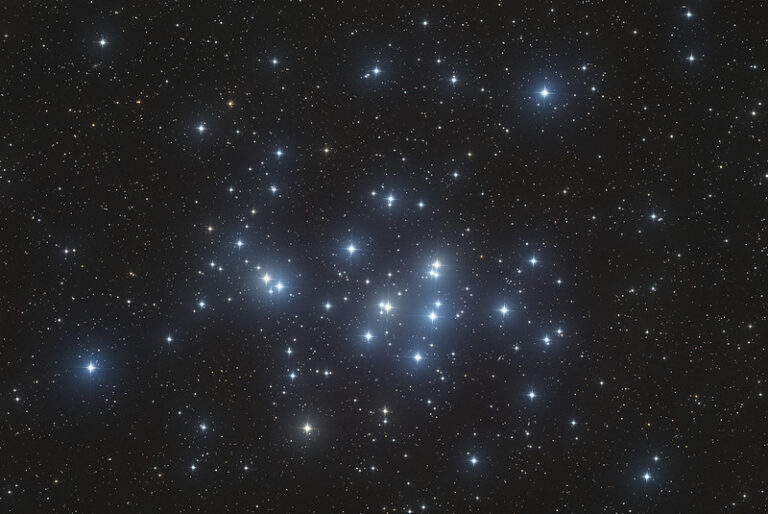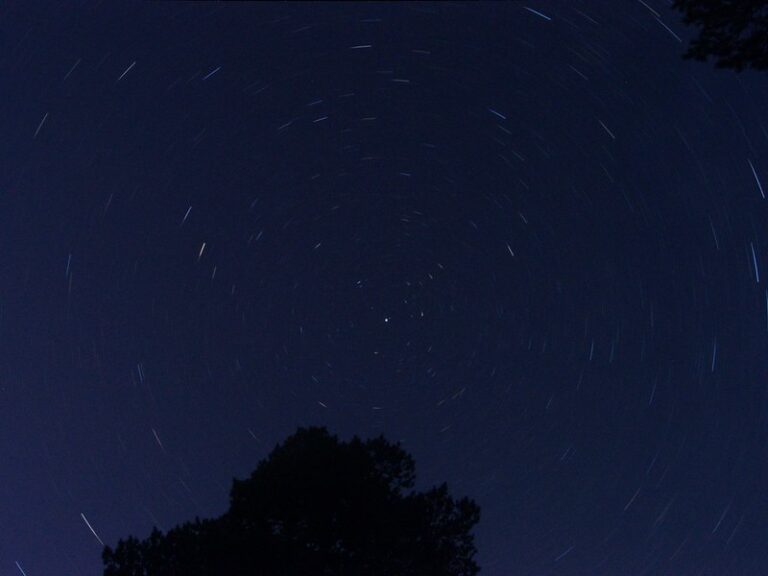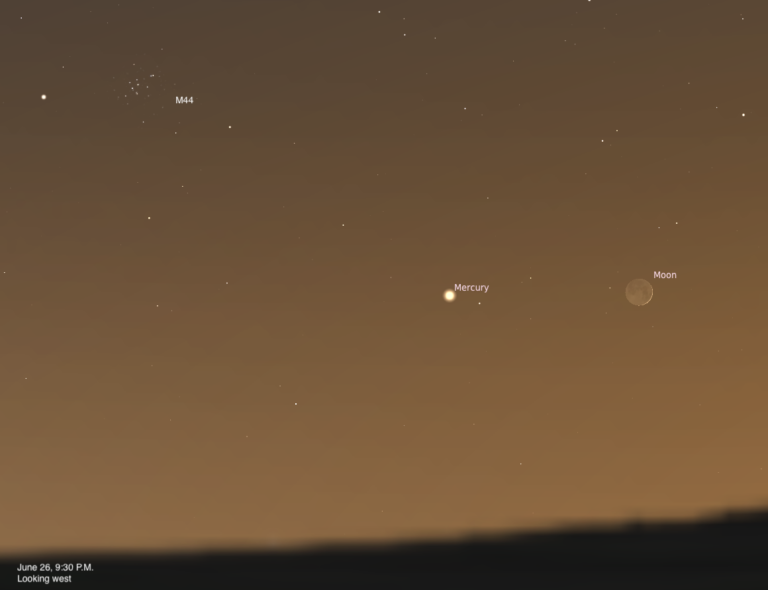Friday, July 15
The Moon passes 4° due south of Saturn at 4 P.M. EDT. Though neither is visible then, the pair rises shortly after 10 P.M. local time tonight and will remain visible until sunrise. By evening, the Moon has moved to a position just over 6° southeast of the ringed planet. Magnitude 0.4 Saturn sits in Capricornus, less than 1.5° north of Deneb Algedi. The Moon, meanwhile, is in Aquarius, now waning after last week’s Full Buck Super Moon.
Also rising around the same time is the Great Square of Pegasus, drawn by connecting four stars to the northeast of Aquarius: Algenib, Markab, Scheat, and Alpheratz. The last star on this list, Alpheratz, is actually part of the constellation Andromeda, where we’ll find tonight’s second target. On the other side of the constellation, 26.7° east-northeast of Alpheratz, is Almach, also known as Gamma (γ) Andromedae. The third-brightest star in Andromeda, Almach is a binary comprising a magnitude 2.3 yellow star and a magnitude 3.6 blue star. At 10″ apart, this pair is easy to split with a small scope.
If you have a larger telescope, though, zoom in on bluish Gamma2, which is also a double — this time separated by a mere 0.4″. Its two stars are nearly the same magnitude. According to Astronomy contributing editor Michael Bakich, you’ll want at least an 11-inch scope to attempt this feat.
Sunrise: 5:44 A.M.
Sunset: 8:28 P.M.
Moonrise: 10:29 P.M.
Moonset: 7:42 A.M.
Moon Phase: Waning gibbous (94%)
*Times for sunrise, sunset, moonrise, and moonset are given in local time from 40° N 90° W. The Moon’s illumination is given at 12 P.M. local time from the same location.
Saturday, July 16
Mercury reaches superior conjunction, when it sits on the opposite side of the Sun from Earth, at 4 P.M. EDT.
Comet C/2017 K2 (PanSTARRS) is already high in the southern sky an hour after sunset. Tonight, the comet — slightly brighter than 9th magnitude and potentially still brightening, according to the Comet Observation database, sits near two globular clusters, offering a great opportunity to compare and contrast these objects. Try to look earlier in the night, before the Moon rises, or use a larger scope (6 inches or more) to maximize the view once moonlight floods the sky.
PanSTARRS is located in the relatively “empty” space between 47 and Delta (δ) Ophiuchi. It’s roughly 8.5° west of magnitude 4.5 47 Oph — or, if you have a go-to scope, you can punch in M10, which is just 1° northeast of the comet tonight. M10 is a magnitude 6.6 globular cluster that spans some 20′ and sits 14,300 light-years away. Compare its bright core and fuzzier outskirts to the comet.
But this is a two-for-one deal: Also nearby is M12, which shines at magnitude 6.1 and is a slightly more compact 16′ in diameter. It looks nearly the same as M10 and tonight sits some 2.9° north-northwest of the comet.
PanSTARRS is traveling southwest, away from both clusters, and will pull away over the next few nights, diving toward Scorpius.
Sunrise: 5:45 A.M.
Sunset: 8:27 P.M.
Moonrise: 11:00 P.M.
Moonset: 8:59 A.M.
Moon Phase: Waning gibbous (88%)
Sunday, July 17
Bright Venus is currently a morning star blazing at magnitude –3.9. It recently passed by the Crab Nebula (M1), which you can try to catch early this morning about 1.5 to 2 hours before sunrise, while the sky is still dark.
The Crab Nebula is a supernova remnant left behind by a massive star that exploded at the end of its life. Ancient astronomers recorded the blast as a “guest star” in the sky that appeared for several months in A.D. 1054. Today, researchers know there is a pulsar — a rapidly spinning neutron star — sitting in the middle of the remnant, sending out regular radio signals we can pick up here on Earth.
At 8th magnitude, you can snag the Crab with a small scope, though moonlight may somewhat hinder your search this morning (so opt for a larger telescope or make a note of this entry and come back once the Moon is closer to New). You can locate it by first finding 4th-magnitude Zeta (ζ) Tauri, then sliding 1° northwest to reach the Crab.
If you’re having trouble, just wait a bit — Venus presents an unmissable target this morning, rising around 4 A.M. local time. Through your scope, you’ll have no problem making out its 11″-wide disk, which is 90 percent lit.
The Moon passes 3° south of Neptune at 9 P.M. EDT. By the time they rise tonight just before 11 P.M. local time, the two are 4° apart. If you want to find magnitude 7.7 Neptune’s bluish disk with binoculars or a telescope, look north-northwest of the Moon.
Sunrise: 5:46 A.M.
Sunset: 8:26 P.M.
Moonrise: 11:27 P.M.
Moonset: 10:12 A.M.
Moon Phase: Waning gibbous (79%)
Monday, July 18
Trekking across the sky along the ecliptic, the Moon passes 2° south of Jupiter at 9 P.M. EDT. But you’ll want to catch them instead in the morning, when Jupiter is 50° high an hour before dawn and the Moon is 10° to the gas giant’s southwest.
Through a telescope, Jupiter is flanked by its four Galilean moons. Callisto sits alone to the planet’s west, while Ganymede (closest), Io, and Europa (farthest) line up to the east. If you happen to be up even earlier, you’ll notice two things: First, Jupiter’s famous Great Red Spot is in the middle of the planet’s 43″-wide disk around 3:15 A.M. EDT. It will continue moving from east to west over the next few hours. And second, Ganymede starts out the morning farther from Jupiter than Io. Moving westward, Ganymede passes Io to sit closer to Jupiter around 5:15 A.M. EDT.
Sunrise: 5:46 A.M.
Sunset: 8:26 P.M.
Moonrise: 11:51 P.M.
Moonset: 11:22 A.M.
Moon Phase: Waning gibbous (69%)
Tuesday, July 19
Pluto reaches opposition at 10 P.M. EDT. Located near the handle of Sagittarius’ Teapot asterism, the distant dwarf planet is rising in the southeast as the Sun sets and is visible all night. Because it’s so small and faint, you’ll want to wait a few hours until it’s higher in a darker sky to try hunting it down. Also make sure to do so before moonrise, as the bright light from our gibbous Moon will wash out the background sky and mask Pluto’s feeble glow.
Pluto is a mere magnitude 14.9, which means only observers with a large (11 inches or more) telescope will be able to readily spot it amid the faint background stars. If you’re going to try, opt for an observing site with a clear view of the southeastern and southern horizon and with minimal to no light pollution.
The best way to search for Pluto is by plugging its Right Ascension and Declination — astronomical coordinates for objects on the sky — into a go-to telescope: 19h58m, –22°50′. Alternatively, you can star-hop starting from magnitude 3.3 Tau (τ) Sagittarii, which marks the lower left corner of the Teapot asterism’s handle. From Tau, skim 11° eastward to magnitude 4.7 Terebellum (Omega [ω] Sagittarii), then move 3° north of that star to magnitude 7.8 SAO 188737. Pluto is 25′ northeast of this star. Take a look at the provided chart or download a high-res PDF below to guide you. Keep an eye on our website as well; on Monday the 18th, we’ll publish a more detailed story dedicated to finding Pluto at opposition, written by Contributing Editor Michael E. Bakich.
Sunrise: 5:47 A.M.
Sunset: 8:25 P.M.
Moonrise: —
Moonset: 12:28 P.M.
Moon Phase: Waning gibbous (59%)
Wednesday, July 20
Last Quarter Moon occurs at 10:19 A.M. EDT. Because the Moon rises after midnight during this phase, it leaves the evening dark enough to observe deep-sky objects.
Tonight, let’s try for one recently made famous by the stunning release of the first images from the James Webb Space Telescope. Stephan’s Quintet is, as the name implies, a group of five galaxies located in Pegasus. When they were first discovered in 1877, astronomers still had no idea the universe was composed of billions — maybe even trillions — of galaxies.
The five members of the group are cataloged as NGC 7317, NGC 7318A, NGC 7318B, NGC 7319, and NGC 7320. They span about 3′ on the sky and the bigger your scope, the better — a 6-inch aperture will net you a singular, clumpy glow, but an 8-incher or larger will start to reveal each individual member. To find the group, look just 4° north-northwest of 3rd-magnitude Matar (Eta [η] Pegasi). The Quintet’s brightest member is NGC 7320, which shines at magnitude 12.5. NGC 7318A and NGC 7318B sit closest together — this magnitude 14 pair is actively interacting, surrounded by gas and dust tugged this way and that by the resulting gravitational forces.
If this grouping is too challenging for your scope or your skies, don’t worry — you can still enjoy Pegasus’ galactic wonders, a mere 0.5° northeast of the Quintet (4.4° north-northwest of Matar). Here lies NGC 7331, a much more achievable magnitude 9.5 spiral. This galaxy is part of another famous group — the Deer Lick Group — that contains four fainter galaxies ranging from magnitude 13 to 15 and sit east of larger NGC 7331.
Sunrise: 5:48 A.M.
Sunset: 8:24 P.M.
Moonrise: 12:14 A.M.
Moonset: 1:33 P.M.
Moon Phase: Waning crescent (49%)
Thursday, July 21
An hour before sunrise, Mars hangs high in the sky, located in southern Aries. The Red Planet, now magnitude 0.3, is roughly halfway between the stars Hamal (magnitude 2) in Aries and Menkar (magnitude 2.5) in Cetus. Through a telescope, Mars’ rust-colored disk appears 8″ across and is 85 percent lit. As it approaches opposition in early December, the planet will slowly wax toward full, changing little by little each month.
A 22-day-old Moon, now 42 percent lit, lies 2.8° west of Mars. Our satellite will pass 1.1° due north of the planet later today at 1 P.M. EDT. In the other direction, the Pleiades (M45) are about 19.7° east-northeast of Mars, across the border in Taurus. This beautiful open star cluster will slowly fade from sight as sunrise approaches and the sky begins to brighten.
Now in Gemini, Venus (magnitude –3.9) sits within 30′ of 3rd-magnitude Propus (Eta Geminorum) this morning. The pair is some 8.5° high an hour before sunrise.
Even as dwarf planet Pluto hangs in the sky all night, the solar system’s other famous dwarf planet, 1 Ceres, reaches conjunction with the Sun at 9 P.M. EDT.
Sunrise: 5:49 A.M.
Sunset: 8:24 P.M.
Moonrise: 12:38 A.M.
Moonset: 2:37 P.M.
Moon Phase: Waning crescent (39%)
Friday, July 22
The Moon passes a mere 0.2° north of Uranus at 2 A.M. EDT. In fact, observers in parts of Africa and South America will see our satellite occult Uranus today, as it passes in front of the more distant ice giant in the sky.
For those in North America, the Moon quickly slides beneath and away from the planet, whose dim magnitude 5.8 glow will require binoculars to pick out. By an hour before sunrise, you can look for Uranus 2.2° west of the Moon; the ice giant is also 3.7° southwest of magnitude 4.3 Botein (Delta Arietis).
The waning Moon will continue moving east along the ecliptic, next passing Venus in a few days’ time.
Sunrise: 5:50 A.M.
Sunset: 8:23 P.M.
Moonrise: 1:05 A.M.
Moonset: 3:40 P.M.
Moon Phase: Waning crescent (30%)

